Hours have been invested into your research and now is the moment to relay your findings. But how can you make your research presentation more than just informative? This article delves into what an outstanding research presentation should look like while exploring examples and offering helpful tips. We’ll also discuss how using Prezi’s advanced features can transform your research presentation into an immersive experience.

Understanding the purpose of a research presentation
The aim of research presentations isn’t just about sharing information but engaging your audience as you reveal your findings. You’re telling the story of your research journey—from the reason why you started it, through the methods you employed, and the discoveries you made. This story-like approach highlights your efforts and also invites valuable feedback that could lead to new insights or collaborations. Presenting your findings through a presentation can also help improve your communication skills which is especially useful for students learning life skills.
The makings of a research presentation
Several elements generally make a research presentation:
- Title slide: Start with the basics—your research title, your name, and where you’re from (your affiliation).
- Introduction: Give some background on your topic, state your research question or hypothesis, and outline the goals of your study.
- Literature review: Summarize the previous research that’s relevant to your study and explain how it relates to what you’re doing.
- Methodology: Describe how you conducted your research. Talk about your methods, procedures, and how you collected and analyzed your data.
- Results: Share what you found. Use tables, graphs, and charts to make your key points clear and easy to understand.
- Discussion: Interpret your results. Explain why they’re important, what they mean, and any limitations your study might have.
- Conclusion: Wrap it up by summarizing your main points, emphasizing the significance of your research, and suggesting areas for future study.
- Q&A: Open the floor to questions from the audience. This is your chance to clarify anything and engage in further discussion.
Best practices for creating a show-stopping research presentation
Now you know what a research presentation should entail, it’s time to start thinking about putting yours together. Explore our tips and tricks to help you get it right:
Know your audience
Before you begin, consider who your audience is. Your presentation should align with their interests and preferences. For instance, if you’re presenting to young students, you might choose brighter colors and visuals that appeal to a younger audience.
Your tone and language should also match your audience. The relaxed language style might not be suitable for professional settings, while overly complex wording might not be appropriate for all audiences. By knowing your audience, you can ensure that your presentation engages everyone.

Keep it simple
Make sure your slides are uncluttered: this can be achieved by aiming at simplicity and precision. Bullet points help in breaking down the information into small, readable chunks while keeping text short and straightforward. This ensures that the audience can capture the main points without feeling overloaded with information. Clear slides will improve readability and allow your audience to focus on your verbal presentation and visual aids.
Use visuals wisely
To effectively illustrate your key points, you might want to consider incorporating charts, graphs, and images. These visual aids can assist in breaking down complex information so it’s easily understandable for your audience. With Prezi, you can convert raw data into appealing dynamic charts or graphs easily with the click of a button. Using Prezi in this way helps you create interesting visuals that not only deliver your data more clearly but also retain the attention of your audience throughout the presentation.
Practice
This might seem obvious, but presenters often underestimate the benefits of regular practice. Practicing helps you remember your presentation better, recall cues, and ensure your words flow naturally. You can also use this opportunity to gain honest feedback from trusted friends or colleagues. Additionally, plenty of practice boosts your confidence and familiarity with the content, so you can truly shine on the big day.
Also, if you’re struggling with managing your nerves before presenting, make sure to follow the tips we cover in our article on how to not get nervous for a presentation.

Tell a story
Organize your presentation like a story with a clear beginning, middle, and end to keep your audience engaged. Start with an introduction that sets the scene, giving the background and goals of your research. Move into the main part where you explain your methods and share your findings, unfolding your research journey step by step. Wrap it up with a conclusion that summarizes the key points and highlights the importance of your results. This structure helps maintain a logical flow and keeps your audience interested throughout.
Learn more on how to best structure your presentation in this video:
Highlight key points
Make your key points known by emphasizing the most important information on your slides. Use bold fonts, vibrant colors, and larger text to make these points stand out. Highlight critical data with eye-catching graphics or unique icons, and consider adding animations to reveal key points one at a time. This not only keeps your audience focused but also makes your presentation more dynamic.
Keep your audience engaged
Keep your audience engaged by incorporating questions, inviting comments, and encouraging interaction throughout your presentation. Start with a few intriguing questions to spark their curiosity. During your presentation, pause occasionally to invite feedback or ask for opinions, making your talk feel more like a conversation. You could add interactive elements like polls or live quizzes to keep things lively and dynamic.
Be prepared for questions
Anticipate possible questions and prepare thoughtful responses to keep your Q&A session smooth and impressive. Think about what might spark curiosity or confusion in your audience, and have clear, concise answers ready. This way, you can handle questions confidently and show off your deep understanding of the topic. You might also prepare a few backup slides with extra data or details to tackle any tricky questions. Being ready for anything not only boosts your confidence but also turns the Q&A into a chance to show off and engage with your audience even more.

Use consistent design
Give your presentation a unique look by sticking to a matching color scheme, font style, and slide layout. Choose a few colors that work well together to create a look that’s easy on the eyes. Use the same font style and size throughout to keep everything looking neat and professional. Keeping your slide layouts consistent helps your audience follow along without any distractions.
Time management
Ensure your presentation fits within the allotted time by practicing with a timer. This helps you see how long each part takes and ensures you’re not rushing or running out of time. Practicing with a timer allows you to deliver a smooth, well-paced presentation that keeps your audience engaged. It also prepares you to handle unexpected interruptions or questions without getting flustered. This approach helps you stay relaxed and make a strong impression.
By following these tips, you can effectively showcase the effort you’ve put into your research. Creating a dynamic presentation that tells a compelling story allows others to fully appreciate the importance of your findings.
And now that your research presentation is ready, learn how to effectively present it by watching the following video:
Prezi research presentation example to spark inspiration
The great thing about Prezi is how versatile the platform actually is. Not only can you create show-stopping presentations with ease, but you can also explore a vast library of Prezi creations. Here’s an example we’ve pulled from the library to show just what you can do with Prezi, and give you ideas for your own research presentation.
Understanding the teenage brain
This Prezi presentation on “The Teenage Brain” is a fantastic example of how to make research presentations engaging and impactful. It uses dynamic visuals, like diagrams and models, to break down complex brain functions and development, making the information easy to grasp. The presentation’s flow is smooth, starting with the basics and diving into the specifics of the teenage brain, ensuring everything is easy to follow.
This Prezi presentation on “The Teenage Brain” is a fantastic example of how to make research presentations engaging and impactful. It uses dynamic visuals, like diagrams and models, to break down complex brain functions and development, making the information easy to grasp. The presentation’s flow is smooth, starting with the basics and diving into the specifics of the teenage brain, ensuring everything is easy to follow.
Prezi’s tools really shine in this example, transforming raw data into interactive charts and graphs that capture attention. The hands-on activities, like building brain models and using sticky notes for brainstorming sessions, get the audience actively involved and deepen their understanding. Plus, the videos and external resources add an extra layer of richness to the content.
Prezi research presentation templates
Not only does Prezi hold a large variety of presentation examples that you can discover in Prezi’s Gallery, but it also provides many pre-set templates to make creating presentations much simpler. No matter the theme of your research presentation, there’s bound to be a template for you. Here are just a few pre-set templates Prezi has to offer that you could use.
Science project presentation template
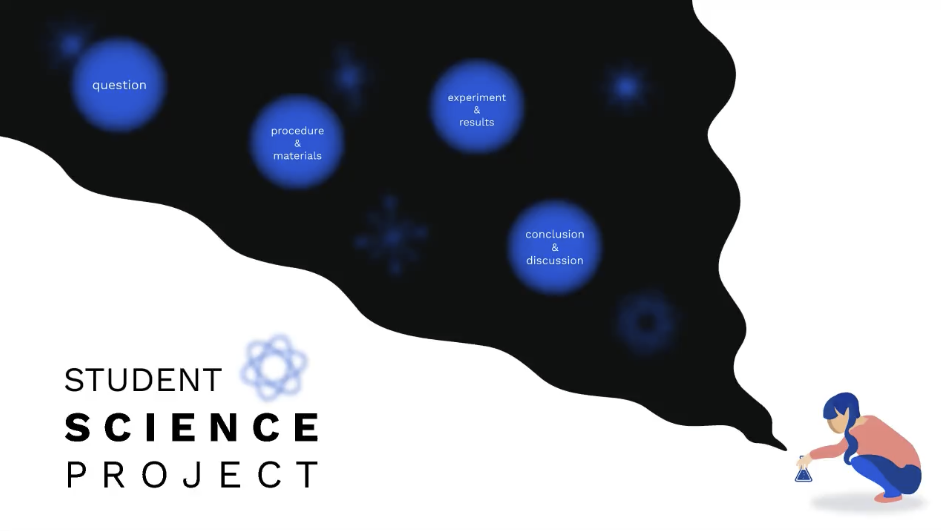
This template is ideal for research presentations because it is divided into four clear sections: question, procedure and materials, experiment and results, and conclusion and discussion. These sections provide a structured framework for organizing all your research data without having to figure out how to split it up and arrange it yourself. Using a template like this streamlines the creation process, making it much easier to compile and present your findings in a clear way.
Purple research project template
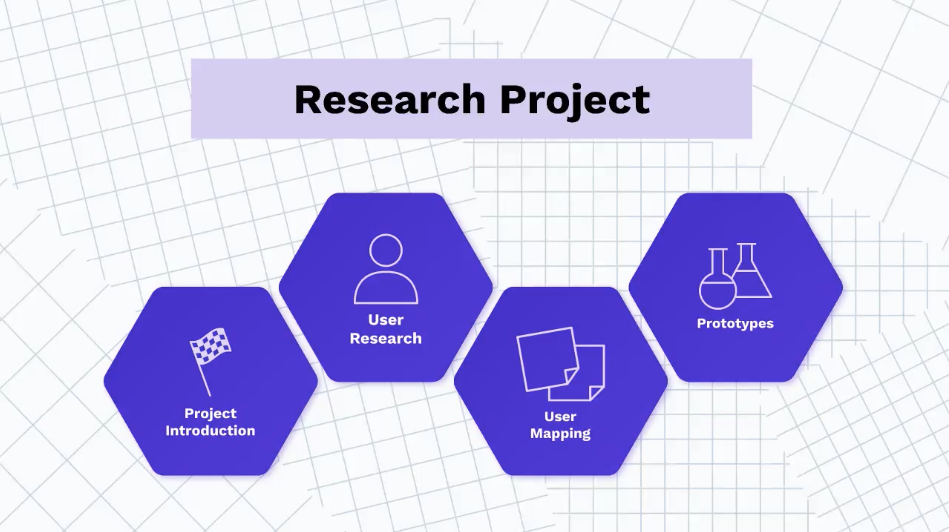
This template is another great tool for simplifying the creation of your research presentation. Like the previous one, it’s already divided into sections, making it easy to organize your data. Additionally, this template stands out for its consistent use of a purple color theme, which keeps the design simple and cohesive. This uniformity helps to maintain audience engagement without distracting them with clashing designs.
Science – cranium (AI-assisted)
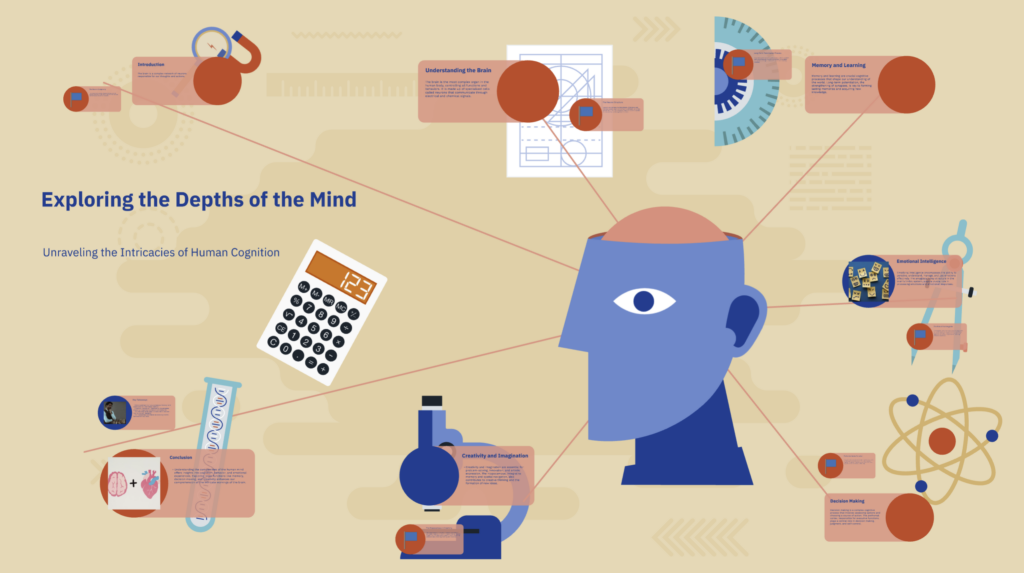
The great thing about this AI-assisted template is that it provides a step-by-step guide for what information to input into each section. For those who find design challenging, this is much easier than starting from scratch. Simply read the prompts in each section and add the relevant information. Like the other templates, this one showcases Prezi’s diverse interface, zooming in and out of key points to highlight important data. This functionality is perfect for research presentations, ensuring your main points stand out effectively.
Explore more Prezi templates here.
The only tool you need for creating the perfect research presentation
If you want your research presentations to truly shine, Prezi should be your go-to tool. Its innovative features and user-friendly design make it an excellent choice for researchers looking to impress their audience. Here are some key features of Prezi that make it ideal for research presentations:
- Zooming user interface (ZUI): Prezi’s unique zooming feature lets you zoom in on the details and then pull back to show the big picture, showcasing your key points and helping your narrative flow naturally.
- Open canvas layout: Forget the boring slide-by-slide format. Prezi’s open canvas lets you lay out your entire presentation in a visually engaging way, allowing you to map out your data dynamically.
- Templates and themes: Prezi offers a variety of slick, customizable templates and themes designed specifically for research presentations, so you can look professional without spending hours on design.
- Multimedia magic: Easily add videos, images, charts, and graphs to bring your research to life and pique your audience’s interest.
- Presenter tools: With Prezi’s presenter view, you can have your notes and prompts handy, helping you deliver a smooth and confident presentation without mishaps.
- Easy sharing and accessibility: Share your Prezi presentations online with ease, and rest assured they’ll look great on any device, reaching a broader audience.
By using Prezi’s unique features, your research presentations turn into captivating stories that grab your audience’s attention and make your findings more interesting.
Introducing the power of Prezi AI
Besides the features we’ve already mentioned, Prezi has introduced a set of helpful AI-powered features. These features transform how presentations are put together, making the process a lot easier. Here’s what Prezi AI brings to the table:
Automatic slide creation: Prezi AI can take your initial ideas, keywords, or even a rough outline and transform them into a fully designed presentation. This includes selecting appropriate layouts and arranging your content in a visually appealing and logical sequence, saving you valuable time.
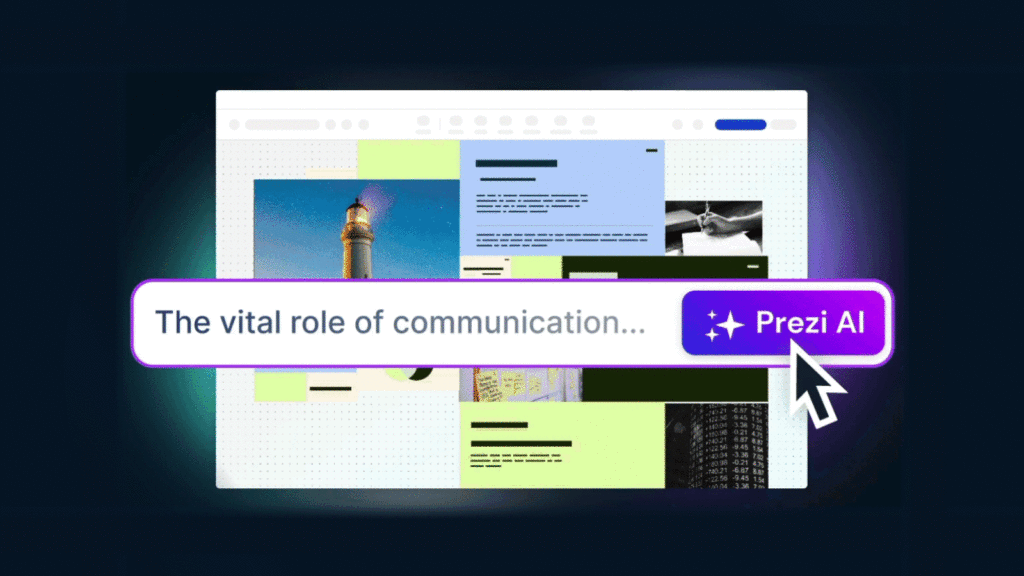
Text editing and enhancement: Struggling to find the right words? Prezi’s AI text editor can suggest improvements, adjust writing styles, and even optimize the length of your text to ensure clarity and engagement.
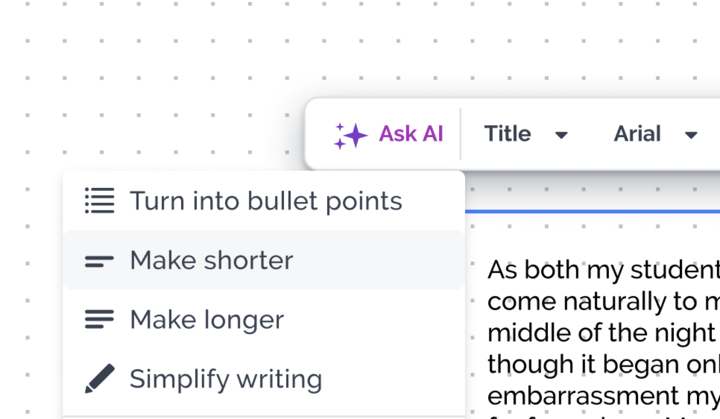
Interactive storytelling: The AI helps craft a narrative by organizing your content into a cohesive story. It ensures that your presentation flows smoothly, guiding your audience through your research in an engaging manner. This approach enhances understanding and retention of your key points.
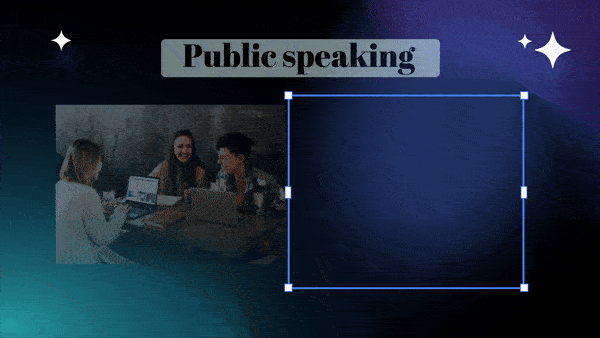
To experience the full potential of Prezi AI for your research presentation, you can start by clicking here.
Discover the Prezi experience for research presentations
To summarize, Prezi is a great option for crafting eye-catching research presentations. Its feature-rich design, smart AI, and narrative tools breathe life into your research information allowing you to deliver compelling visual stories that capture your viewers’ attention right through to the very last slide. Making use of Prezi enables you to take pride in your research discoveries and promote audience enthusiasm— so why not go ahead and make them as equally interested in your findings as you are? If you aim to make your presentations unforgettable, then using Prezi can be one way of achieving that goal.
